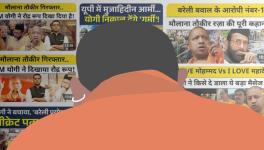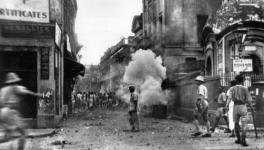Hathras Tragedy: Gandhi Must be Turning in His Grave
The Uttar Pradesh police has raped and murdered the ‘evidence’ of a rape and murder by hastily cremating the body of the victim of brutal atrocity in Hathras. A living human might lie in the court of law, but a dead body is a truthful witness, almost unflinching evidence in a criminal case. The UP police knows that the only way of letting off the criminals is by destroying the clinching evidence – the dead body of the victim of rape and murder.
The state’s police force deserves to be prosecuted for destroying evidence, as Section 201 of the Indian Penal Code says:
S 201. Causing disappearance of evidence of offence, or giving false information to screen offender—
Whoever, knowing or having reason to believe that an offence has been committed, causes any evidence of the commission of that offence to disappear, with the intention of screening the offender from legal punishment, or with that intention gives any information respecting the offence which he knows or believes to be false; if a capital offence.—shall,
if the offence which he knows or believes to have been committed is punishable with death, be punished with imprisonment of either description for a term which may extend to seven years, and shall also be liable to fine;
if punishable with imprisonment for life — and if the offence is punishable with imprisonment for life, or with imprisonment which may extend to ten years, shall be punished with imprisonment of either description for a term which may extend to three years, and shall also be liable to fine;
if punishable with less than ten years’ imprisonment — and if the offence is punishable with imprisonment for any term not extending to ten years, shall be punished with imprisonment of the description provided for the offence, for a term which may extend to one-fourth part of the longest term of the imprisonment provided for the offence, or with fine, or with both.
Let us resort to an illustration. A, knowing that B has murdered Z, assists B to hide the body with the intention of screening B from punishment. A is liable for imprisonment of either description for seven years, and also has to pay a fine.
The involvement of authorities in shielding criminals is the gift by the UP government to the criminal justice system on the 151st birth anniversary of father of the nation, who dreamt of a peaceful and prosperous India after Independence.
The Allahabad High Court judges, who took suo moto cognisance of the matter, felt the need to remind the state of certain principles. They quoted Mahatma Gandhi, saying, “This is a time to strengthen our resolve to live up to the ideas which ‘Bapu’ stood for, but, unfortunately, ground realities are very different from the high values propagated and practised by the Father of our Nation.”
A Shocked Nation
It is indeed shocking that the UP police was out in full force to cremate the woman from Hathras away from her family. Media reports have established that from the time her body left Delhi’s Safdarjung Hospital at 9:30 pm on September 29, to a hurried cremation in the village about 200 kms away at 3:30 am on September 30, the 19-year-old’s final journey was marked by a disregard for protocol. The heavy handedness of a police force that did not let her family perform her last rites was on display. It was alleged that the police took the father and brother of victim away from Safdarjung Hospital in Delhi, after persuading them to end a dharna.
At 9:30 pm on Tuesday, the victim’s body was released and taken to Hathras in an ambulance with one constable, with the family not informed. The father reportedly said: “We had been waiting all day to take her home, do the rituals, the last rites… The police did not inform us deliberately. In a medico-legal case, the body is handed over to the police following the post-mortem. It is then the job of the police to hand it over to the family following a verification process”.
While the body was on its way, district authorities and the police began preparation for a late-night funeral – arranging logs of wood, had the lights at the cremation ground switched on and the road to the victim’s home was heavily barricaded.
Surprisingly, the SP claimed that after the post-mortem, the body was handed over to the family. “The administration only provided logistical support to transport the body. In fact, the father told me more than once that the time the cremation was done would not matter,” he said.
By one am, the ambulance had reached the village, passing at least three layers of barricades which sat between the main road and the victim’s home, which was already swarming with the police. As the ambulance stopped at around 100 metres from the woman’s home, also equidistant from the arranged cremation ground, her family and locals asked to take her body inside the house. When the conversation flared-up point, an anonymous official acknowledged that there were instructions in place to wrap up the cremation at night in order to prevent a “law and order situation” in the morning.
“The ambulance headed straight to the cremation spot… My mother fell on their feet, the women from the family cried on the bonnet, we folded our hands… My mother said let me put haldi on her, let me take her home one last time… But no one heard us,” the woman’s brother was quoted saying. The area was full of senior officials like the DM, SP, circle officers and others. Besides, 200 personnel of the Provincial Armed Constabulary and forces from all 11 police stations of the area were deployed over two shifts.
At around three am the conversation became heated since the family were resisting cremation with district authorities and the police insisting on it. Her brother told the media: “At one point, police personnel got aggressive and pushed, kicked some relatives who were trying to intervene. That’s when we became so scared that we locked ourselves in… We were afraid we would be lathicharged”.
The now-suspended Hathras DM, Praveen Kumar Laxkar, told The Indian Express: “The funeral was carried out by the family members. Senior officials oversaw the entire process and it was done with their consent. The news circulating otherwise is baseless.” However, the same newspaper reported that a relative told them that he was forced to do so.
The Lucknow bench of the Allahabad HC referred to this report, saying, “In this regard we have taken note of a news reported in Indian Express, Lucknow edition dated 01.10.2020, with the headline ‘U.P. Police out in full force to cremate Hathras women, away from family’… and decided to step in to review state action around the brutal crime.
The HC Bench directed family members of the deceased to be present that day so that the court could hear their version of the cremation organised by the police in the middle of the night, and wondered if the authorities acted so due to the family’s economic status. It also said that it would decide “as to the necessity of monitoring the investigation or getting it conducted through an independent agency as per law”.
The Brutality of Criminals and the State’s Role
The Hathras brutality is not a routine crime. Taking suo moto notice of the ghastly crime with ‘state authorities’ protecting the suspects, the Allahabad HC rightly observed: “It involved allegations of high-handedness by the state authorities resulting in violation of basic human and fundamental rights not only of the deceased victim but also her family members.”
The shocked Justices, Rajan Roy and Jaspreet Singh, said: “The incidents which took place after the death of the victim on 29.09.2020 leading up to her cremation, as alleged, have shocked our conscience. As it is, the deceased victim was treated with extreme brutality by the perpetrators of the crime and what is alleged to have happened thereafter, if true, amounts to perpetuating the misery of the family and rubbing salt in their wounds.”
The bench further said: “We are inclined to examine as to whether there has been gross violation of the fundamental rights of the deceased victim and the family members of the victim; whether the State Authorities have acted oppressively high handed and illegally to violate such rights as if it is found to be so, then, this would be 9 a case where accountability will not only have to be fixed but for future guidance also stern action would be required.”
On October 1, the UP police claimed that the forensic lab report showed that the woman was not raped. However, experts pointed out that since the samples for the test were collected days after the crime, sperm would not be present. According to NDTV, the autopsy report of the woman showed that she was strangled and suffered a cervical spine injury. The final diagnosis did not mention rape but pointed out that there were tears in her genitalia.
It makes it clear that police is trying to do away with the evidence, showing its resolve to hush up the case and shield criminals.
Dr. M. Sridhar Acharyulu is former Central Information Commissioner. Views are personal.
Get the latest reports & analysis with people's perspective on Protests, movements & deep analytical videos, discussions of the current affairs in your Telegram app. Subscribe to NewsClick's Telegram channel & get Real-Time updates on stories, as they get published on our website.
























